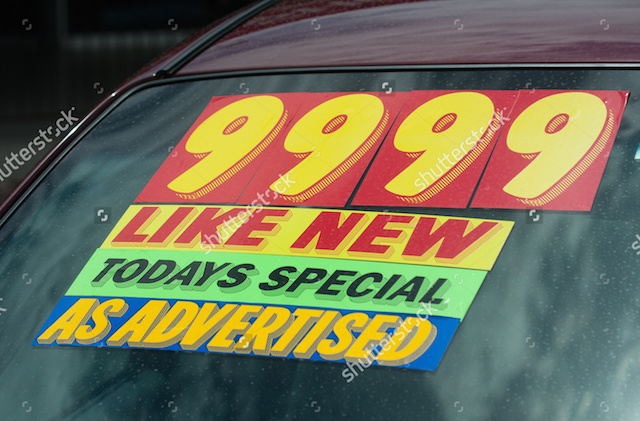
New vehicle registrations in New Zealand after the first three months of 2017 are around 13 per cent up on the same period last year – but pre-registrations fluctuated.
Pre-registrations, or first registrations, are those vehicles registered by distributors and/or dealers before they are actually sold to an end user.
Of the leading nameplates in January-March, Toyota pre-registered 12.5 per cent of its vehicles and Ford 21.4 per cent. That’s up from last year’s 9.3 per cent and 19.2 per cent respectively.
Holden on the other hand pre-registered fewer vehicles January-March than last year – 19.8 per cent against 28.8 per cent. So did Mazda and Mitsubishi, as shown by the figures below.
In fact, many carmakers did the same, a pointer to continued growth. But there were exceptions, including some prestigious nameplates.
At the end of March, the NZ Transport Agency had registered 39,477 new vehicles compared with 34,316 for the same period last year.
The NZTA doesn’t record actual sales, only registrations. Its monthly numbers are picked up by the Motor Industry Association (MIA), the distributors’ representative.
So how many of the 39,477 vehicles in the first quarter of 2017 were pre-registrations? It’s industry practice, what distributors and dealers do. Have done for years. It’s discounting by another name.
It allows salesmen to say, ‘Boy, have we got a deal for you. It’s a demo. Hardly driven. Ony a few kays on the clock.’ The reality is, of course, salesmen need demos to show punters.
Most industry executives say the more pre-registrations a carmaker logs, the more it devalues the brand. Some go as far as to say that a new vehicle registered by a dealer in February, for example, and sold with a few kays on the clock in May, is essentially second-hand.
Let’s look at carmakers with the most registrations of passenger cars and/or light commercials in the first three months of 2017 and compare their numbers and statistics with the same three months last year.
The first figure is NZTA registrations, the second dealer and/or distributor demonstrators, the third percentage of such:
######################
2017: Toyota: 6389 – 799 (12.5%)
2016: Toyota: 5650 – 524 (9.3%)
######################
2017: Ford: 4410 – 943 (21.4%)
2016: Ford: 3971 – 762 (19.2%)
######################
2017: Holden: 3881 – 769 (19.8%)
2016: Holden: 3027 – 872 (28.8%)
######################
2017: Mazda: 2969 – 462 (15.6%)
2016: Mazda: 2579 – 503 (19.5%)
######################
2017: Mitsubishi: 2751 – 277 (10.1%)
2016: Mitsubishi: 2289 – 365 (15.9%)
######################
2017: Nissan: 2073 – 388 (18.7%)
2016: Nissan: 2038 – 284 (13.9%)
######################
2017: Hyundai: 2119 – 573 (27.0%)
2016: Hyundai: 1973 – 533 (27.0%)
######################
2017: Suzuki: 2093 – 331 (15.8%)
2016: Suzuki: 1359 – 243 (17.9%)
######################
2017: Volkswagen: 1529 – 387 (25.3%)
2016: Volkswagen: 1302 – 460 (35.3%)
######################
2017: Honda: 1297 – 51 (3.9%)
2016: Honda: 1099 – 142 (12.9%)
######################
2017: Kia: 1741 – 320 (18.4%)
2016: Kia: 1077 – 246 (22.8%)
######################
2017: Mercedes-Benz: 894 – 270 (30.2%)
2016: Mercedes-Benz: 729 – 227 (31.1%)
######################
2017: Subaru: 783 – 193 (24.6%)
2016: Subaru: 677 – 185 (27.3%)
######################
2017: BMW: 554 – 275 (49.6%)
2016: BMW: 592 – 327 (55.2%)
######################
2017: Isuzu: 613 – 187 (30.5%)
2016: Isuzu: 574 – 142 (24.7%)
######################
2017: Ssangyong: 437 – 46 (10.5%)
2016: Ssangyong: 556 – 89 (16.0%)
######################
2017: Audi: 533 – 209 (39.2%)
2016: Audi: 455 – 137 (30.1%)
######################
2017: Land Rover: 311 – 79 (25.4%)
2016: Land Rover: 430 – 95 (22.1%)
######################
2017: Skoda: 282 – 120 (42.6%)
2016: Skoda: 329 – 97 (29.5%)
######################
2017: Jeep: 221 – 104 (47.1%)
2016: Jeep: 302 – 158 (52.3%)
######################
2017: Peugeot: 183 – 62 (33.9%)
2016: Peugeot: 207 – 68 (32.9%)
######################
2017: Mini: 177 – 83 (46.9%)
2016: Mini: 172 – 96 (55.8%)
######################
2017: Lexus: 183 – 83 (45.4%)
2016: Lexus: 168 – 61 (36.3%)
######################
2017: Volvo: 155 – 67 (43.2%)
2016: Volvo: 156 – 71 (45.5%)
######################
2017: Dodge: 93 – 46 (49.5%)
2016: Dodge: 113 – 40 (35.4%)
######################
2017: Jaguar: 102 – 43 (42.2%)
2016: Jaguar: 99 – 58 (58.6%)
######################
Some of the smaller marques:
2017: Alfa Romeo: 21 – 1 (4.8%)
2016: Alfa Romeo: 56 – 35 (62.5%)
######################
2017: Renault: 105 – 30 (28.6%)
2016: Renault: 50 – 19 (38.0%)
######################
2017: Citroen: 53 – 14 (26.4%)
2016: Citroen: 45 – 11 (24.4%)
######################
NZTA registrations show first quarter 2017 numbers compared with the same period in 2016:
Up are: Toyota 13%; Ford 11%; Holden 28.2%; Mazda 15.1%; Mitsubishi 20.1%; Nissan 1.7%; Hyundai 7.3%; Suzuki 54%; Volkswagen 17.4%; Honda 18%; Kia 61%; Mercedes-Benz 22.6%; Subaru 15.6%; Isuzu 6.7%; Audi 17.0%; Mini 2.9%; Lexus 9.0%; Jaguar 3.0%; Renault 110.0%; Citroen 17.7%.
Down are: BMW 8.0%; Ssangyong 21.4%; Land Rover 27.6%; Skoda 14.2%; Jeep 26.8%; Peugeot 11.5%; Volvo 0.6%; Dodge 17.6%; Alfa Romeo 62.5%.
